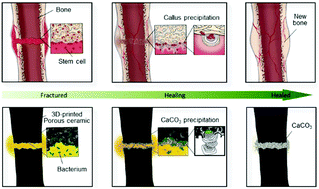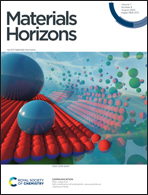Bone-inspired healing of 3D-printed porous ceramics†
Abstract
Emerging 3D-printed ceramics, though showing unprecedented application potential, are typically vulnerable to fractures and unable to heal at room temperature. By contrast, their natural counterparts, human bones, exhibit extraordinary self-healing capability through the activation of stem cell osteoblasts that precipitate mineralized calluses to enable interfacial healing at body temperature. Inspired by bones, we here employ bacteria as artificial osteoblasts to enable healing of 3D-printed porous ceramics at room temperature. The healing behavior relies on bacteria-initiated precipitation of calcium carbonate crystals to bridge fracture interfaces of ceramics. We show that bacteria-loaded porous ceramics can heal fracture interfaces to restore 100% mechanical strength at room temperature, and the healed strength is not compromised by heating up to 500 C or by corrosion of alkalis and oxidants. The bacteria-assisted healing mechanism is revealed by systematic control experiments, and the healing strength is explained by cohesive fracture modeling. We further incorporate this method into 3D-printed ceramics and demonstrate on-demand healing of ceramic dental crowns, ceramic water membranes, and ceramic lattices, and autonomous healing of ceramic armor. As the first-generation healing mechanism of 3D-printed ceramics, this paradigm is expected to open promising avenues for revolutionizing the low-damage-tolerance nature of existing 3D-printed ceramics.



 Please wait while we load your content...
Please wait while we load your content...
